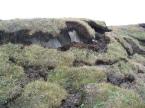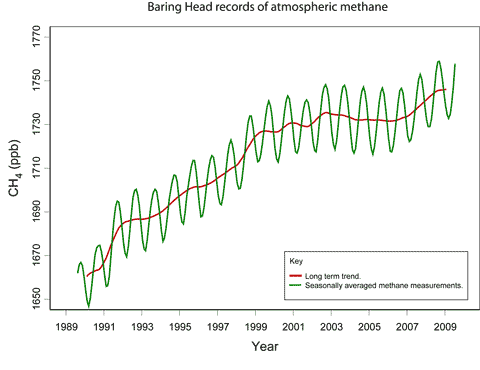 More cautionary news on rising methane levels is reported in yesterday’s Independent. Two leading experts on CH4in the atmosphere, Euan Nisbet and Ed Dlugokencky, were due to reveal at a conference that, after a decade of near-zero growth, “globally averaged atmospheric methane increased by [approximately] 7ppb (parts per billion) per year during 2007 and 2008.” They consider it likely that 2009 will have shown the same rising trend, since the figures for the first half of the year showed a 7 ppb rise on the 2008 level.
More cautionary news on rising methane levels is reported in yesterday’s Independent. Two leading experts on CH4in the atmosphere, Euan Nisbet and Ed Dlugokencky, were due to reveal at a conference that, after a decade of near-zero growth, “globally averaged atmospheric methane increased by [approximately] 7ppb (parts per billion) per year during 2007 and 2008.” They consider it likely that 2009 will have shown the same rising trend, since the figures for the first half of the year showed a 7 ppb rise on the 2008 level.
They are properly cautious about the rises and comment that they may just be a couple of years of high growth which may drop back to what it was. But they stress the importance of understanding the causes of the rises, because of the potential for increased CH4 emissions from strong positive climate feedbacks in the Arctic where there are unstable stores of carbon in permafrost. Permafrost melt carries the potential for methane release.
If there is a feedback mechanism at work it’s bad news as the Independent makes clear in terms that its readers can understand:
“Many climate scientists think that frozen Arctic tundra… is a ticking time bomb in terms of global warming, because it holds vast amounts of methane, an immensely potent greenhouse gas. Over thousands of years the methane has accumulated under the ground at northern latitudes all around the world, and has effectively been taken out of circulation by the permafrost acting as an impermeable lid. But as the permafrost begins to melt in rising temperatures, the lid may open – with potentially catastrophic results”.
This is not alarmism on the part of the Independent. The scientists involved in reporting the rises are careful and restrained in their statements. We may hope that the increases turn out not to be significant in terms of feedbacks under way. But it is a sober reminder of how quickly things may change if natural feedbacks kick in and amplify the warming already caused by our human activity. See Gareth’s earlier post on methane hydrates in the Arctic.
Incidentally, it was good to see a newspaper competently and thoroughly reporting climate change science news. It can happen, and when it does it’s a different world from the ignorant and careless journalism that has been so apparent recently in relation to the UEA emails and the IPCC report. Rationality and proportion marked an excellent piece of science reporting.

 During the Copenhagen kerfuffle a lot of interesting stuff hit the web: here’s something that deserves a bit more air – a Proceedings of the National Academy of Science (PNAS)
During the Copenhagen kerfuffle a lot of interesting stuff hit the web: here’s something that deserves a bit more air – a Proceedings of the National Academy of Science (PNAS)  Methane release from the permafrost and hydrates under the East Siberian Shelf in autumn 2009 was the highest ever recorded, the leader of the International Siberian Shelf Study (ISSS), Igor Semiletov, has
Methane release from the permafrost and hydrates under the East Siberian Shelf in autumn 2009 was the highest ever recorded, the leader of the International Siberian Shelf Study (ISSS), Igor Semiletov, has 